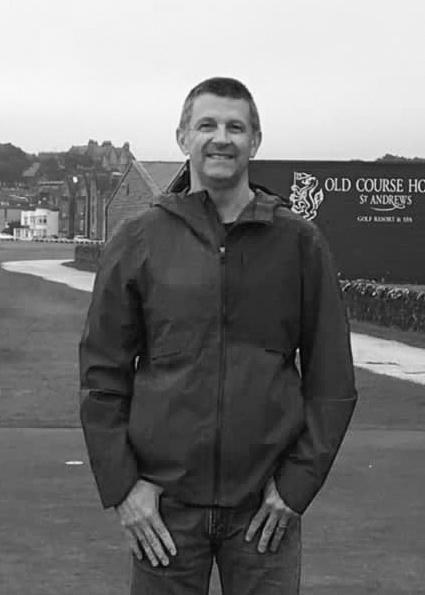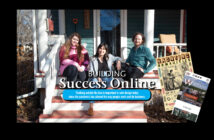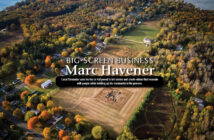| story by | |
| photo by | Steven Hertzog |
| OPEN A PDF OF THE ARTICLE |
Radio seized the opportunity to expand its content and its reach.
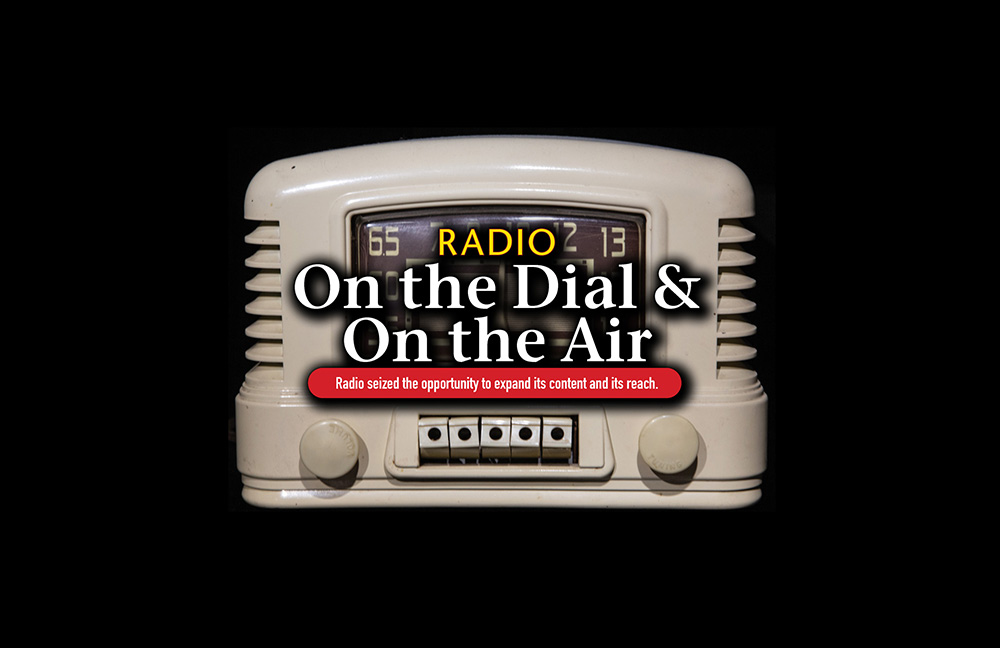
On the Dial – On the Air
The advent of the internet in the 1990s and early 2000s effectively flipped the world of media upside-down. Instead of getting news and information by walking to the end of the driveway and picking up the newspaper, or tuning in to the nightly newscast, with a computer and modem connection—or today, a Wi-Fi signal—it seemed the entire world was at our fingertips.
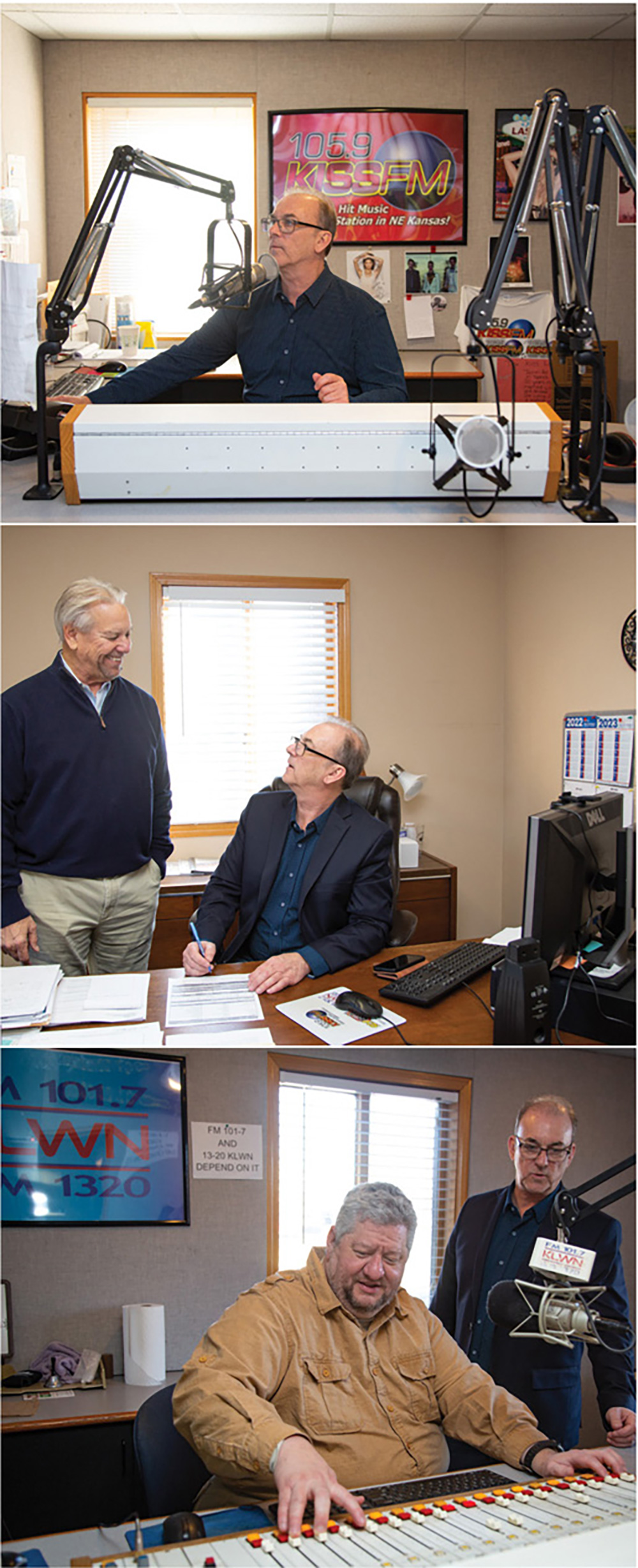
top to bottom Jonathan Monk recording in the Great Plains Media studios, Monk with Great Plains Media owner Jerry Zimmer, Monk with Joel Becker, Great Plains Media program director/ on air personality
As a result, over the next couple decades, what was known as a robust print industry was hit hard and greatly contracted. With consumers of news and information now reading online—and advertising dollars following suit—newspapers fell by the wayside or condensed in staff and size so much they were shadows of what they once were. Same for magazines, many of which either shifted to online presences or went away altogether. Television, with ratings already splintered mightily by the dawning of cable, watched its audiences further siphoned by streaming services such as YouTube.
During this seismic shift, there was one form of media that bucked the trend. While the print and TV industries hustled to adapt and find solutions to the changing landscape, radio saw opportunities to take the content it had been producing all along and simply expand its reach. Now, instead of broadcasting on a limited-scope AM or FM signal, radio seized the opportunity to throw content onto the World Wide Web for anyone around the globe to access and hear.
“Even though we choose to use the name Kansas Public Radio, we could’ve really changed it to Kansas Public Media,” says Dan Skinner, director of Kansas Public Radio (KPR), a Lawrence-based station which last year was named the Kansas Association of Broadcasters Station of the Year for the 21st time, more than any radio outlet in the state.
“We’ve never looked at (traditional and internet radio) as either/or, but and,” Skinner says. “Now we have listeners beyond our terrestrial broadcast reach. People all over the world listen to our programming. It’s been great for us, and I think great for all radio.
“To me,” he continues, “it was never a subtraction, just an enhancement of everything we do.”
KPR is one of two Lawrence radio organizations that have taken the age of the internet and run with it.
Just a couple miles west from KPR’s headquarters sits Great Plains Media Inc., a collective of three local stations—KLWN FM 101.7/ 1320 AM, KISS-FM 105.9 and 92.9 The Bull—that broadcast in Lawrence and the surrounding area. And of course, with internet, that area can be the world. In addition, the company has a pure-play internet adult-rock radio station at LAZERROCKS.com.
“I think radio has been at the forefront of being a disrupter,” says Jonathan Monk, executive vice president for Great Plains Media. “For instance, with music, over the years, everything went from vinyl to being on the computer. We take local content and put it on different formats, whether it be streaming or putting it on an app.
“Facebook, Instagram … We’ve brought in all those formats to adapt to the times. We’re a content provider of music and local information.”
LOCAL MATTERS
Our Local Advertisers – Making a Positive Impact
Monk is quick to point out that, according to data compiled by Neilsen Audio Today in June 2022, 93 percent of Americans 18 and older still listen to terrestrial radio on a monthly basis.
“Listener habits have changed,” he says. “Where they are listening, when and what kind of content they are listening to. But I think radio can create whatever it wants to create.
“If we can keep putting out interesting, relevant content and give it to people when and where they want it, then I think it’s a very exciting time for radio,” he adds.
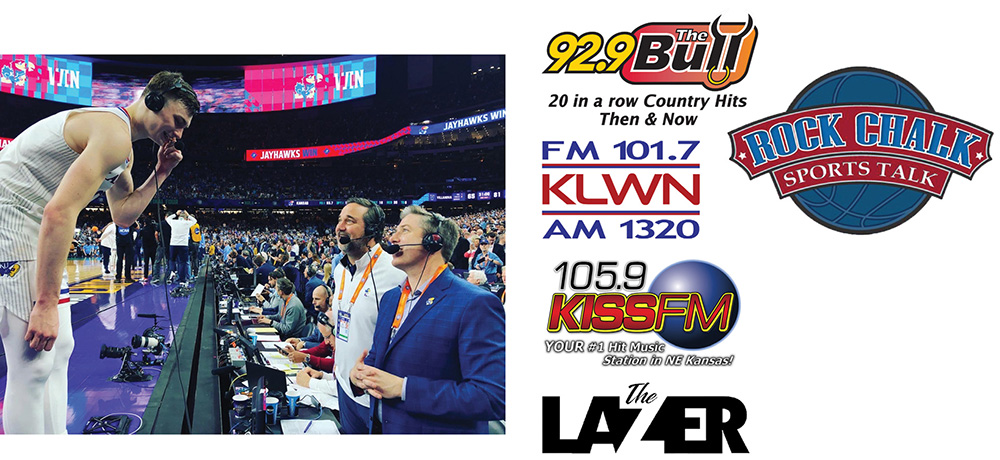
Brian Hanni, right, with Greg Gurley talking with Christian Braun after the 2022 NCAA Championship win.
The Original Home for KU Sports and More
Brian Hanni, the “Voice of The Jayhawks” the past seven years on the Jayhawk Radio Network, which includes KLWN and KISSFM, for University of Kansas (KU) sporting events, says he’s always pleasantly surprised when he hears from listeners of his broadcasts from far reaches of the globe.
“I’ve heard from listeners from such places as Brazil and Japan,” he says. “It always makes me smile. And I always make a point of showing (those correspondences to KU men’s basketball) Coach (Bill) Self.”
Hanni points out that KLWN had more than a million downloads on all formats during the 2022 KU football season.
“We’re blessed to get to call games, and there’s no better place to call college basketball games than Allen Field House,” he says. “This is just a tremendous place to call home. You can just sense how special the sports community is, the passion of the fan base.
“I hear from folks every day who turn down the volume on their TVs to listen to the radio broadcast,” he continues.
Listenership is exponentially greater than when then-owner Arden Booth first launched the station back in 1951. Following Arden’s death, the Booth family sold the station in the late ’90s to the Zimmer brothers—specifically Jerry Zimmer—who folded the three stations under the Great Plains Media banner. For more than 50 years, Arden’s son, Hank Booth, has hosted a morning talk show, “According to the Record,” on KLWN and served primarily as the soul of the station.
“We have the heritage of Hank Booth,” Monk says. “And Arden’s spirit is still with us.”
While KU sports attracts a good portion of its listeners, KLWN also is known for an array of local news and talk shows. “Radio for Grownups With Joel Becker” interviews anyone from local realtors and psychologists to members of the Lawrence Chamber of Commerce. “Timeline With Clenece Hills” takes an uberlocal approach to covering topics pertinent to Lawrence and the surrounding areas. There’s also “This Morning With Gordon Deal” and “Rock Chalk Sports Talk With Derek Johnson and Nick Springer.” And, for in-depth stories on local businesses and community leadership, tune into the “Lawrence Business Magazine Radio Show With Steven Hertzog,” at 9 a.m. Thursdays.
KLWN also broadcasts football games for both Lawrence High School and Free State High School.
“Sports is very crucial to the health and well-being of our company and community,” Monk says.
KLWN also offers nationally syndicated broadcasts like “No Spin News With Bill O’Reilly.” As part of its adaptation to the internet times, the station offers all its programming on podcasts, so listeners can enjoy absorbing content on their own time and terms.
KISS-FM is, in Monk’s words, “a contemporary hit radio station.” It has the strongest signal of the three Great Plains properties—100,000 watts—so has a longer range and also carries KU basketball and football games.
92.9 The Bull is a country music station that plays songs from the ’90s to today, “a wide variety of hit music that people enjoy,” he explains. Both KISS-FM and The Bull often highlight bands that come through town and play at one of Lawrence’s famed venues, like Liberty Hall, The Granada or The Bottleneck.
Monk says all three Great Plains stations take their roles seriously as civic community members and contributors. Programs such as “KLWN Cares” and “KISS Cares” highlight different organizations in the community, such as the Coaches Versus Cancer program.
“Radio is actually a very intimate industry,” he says. “It’s very personal, very one on one. One of the most important things about local radio is that we’re here to help local businesses grow.”
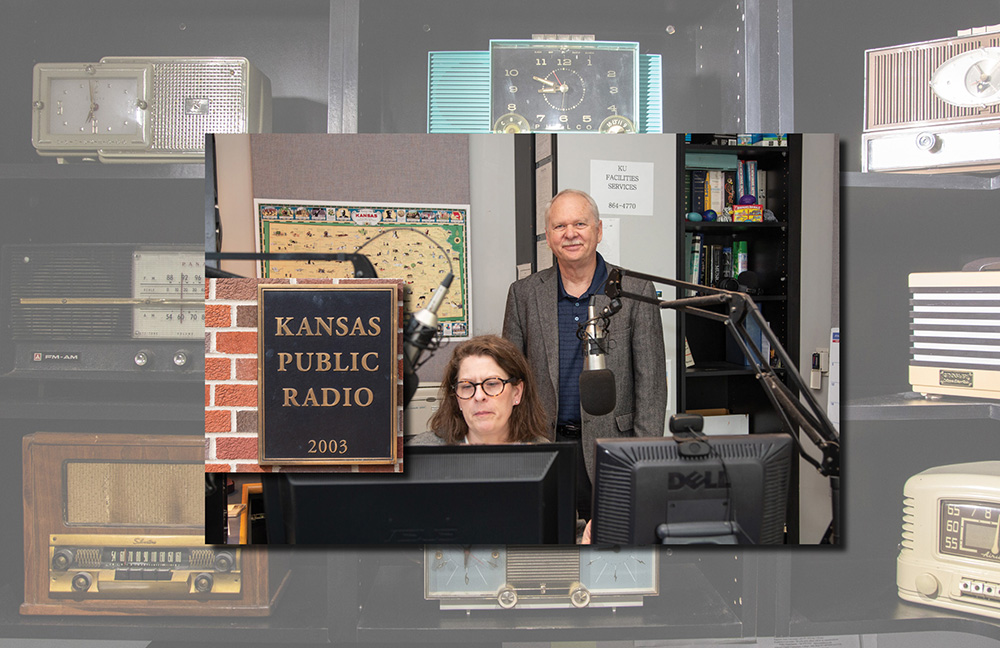
Dan Skinner, director of Kansas Public Radio and Laura Lorson, host/producer of All Things Considered
Entertaining and Educational
Kansas Public Radio was born out of a single station, KANU 91.5 FM, on Sept. 19, 1952. It was quite fitting that, last Sept. 19, KPR celebrated its 70th anniversary with a day full of live classical music.
“Classical and jazz have been there from the beginning,” KPR Directory Skinner says. “They’ve stayed there because there’s always been an audience for it.”
As KANU’s reach expanded, so did its offerings to listeners; and in 1971, the station began broadcasting one of its programming mainstays to this day, National Public Radio’s “All Things Considered.” It wasn’t until July 1985 that KANU began broadcasting 24 hours a day, seven days a week.
Soon thereafter, in 1986 and ’87, KANU expanded service to Emporia and Manhattan. The next year, Iola and Humboldt, Kansas, were added. At the beginning of 1990, KANU’s Statehouse Bureau became Kansas Public Radio, with stations in Garden City, Manhattan, Pittsburg and Wichita, receiving legislative coverage for a modest fee.
Later, KANU began service to Atchison and Emporia/Lyon counties. On June 1, 2002, with broadcast towers in Atchison, Emporia and Lawrence, and one planned for Junction City, KANU officially changed its name to Kansas Public Radio to represent its entire broadcast area.
Two memorable events during those first 50 years occurred when a June 15, 1991, lightning strike set Hoch Auditorium ablaze, destroying KANU’s development offices and considerable archival material; and in March of ’95, a TV crew from “60 Minutes” visited the station to shoot footage of an “Imagination Workshop” broadcast for a piece about Congress’ move to withdraw funding for public broadcasting.
Today, KPR employs 22 full- and part-time staff.
“We try to fill the gaps of what commercial stations don’t offer,” Skinner says. “It’s the variety. A lot of radio has become somewhat monolithic, but because of the great range of our listenership, eclecticism has served us well.”
Another feature of KPR is that most of its shows are hosted by locals, many of whom are experts in their fields. Bob McWilliams, a local jazz enthusiast, hosts “Trail Mix,” the station’s main jazz show. Local jazz legend David Basse hosts another jazz show. Cordelia Brown, a classical musician herself, hosts a classical music show.
“I think that’s what sets public radio apart,” Skinner says. “We have local hosts with local knowledge that not only is entertaining but educational.”
He explains the mainstays of the station’s news offerings come from NPR but with local news breaks inserted into those broadcasts. In November 2017, KPR entered into a collaboration with KMUW, KCUR and High Plains Public Radio to form the Kansas News Service. It’s longstanding history of covering the Kansas Statehouse made it an easy choice for its contribution to the allegiance.
Skinner says 84 percent of KPR’s income comes from public contributions, either from individual members or corporate underwriters. Five percent comes from KU, 9.4 percent from federal grants and 1.2 percent from the state.
He thinks KPR will be subsidized more and more by public contributors in the future. But it’s full steam ahead for Kansas Public Radio and the unique kind of content it provides listeners in the area.
“We’re proud to continue to provide what we think is a valuable public service to the community, and we could not do it without the support of the public, which we remain very thankful for,” Skinner says.


